PROTECT YOUR DNA WITH QUANTUM TECHNOLOGY
Orgo-Life the new way to the future Advertising by AdpathwayMany people stay out of gardening because they don’t have the space. But just because you have less space than your local market farmers, doesn’t mean you should give up. Instead, try growing in 5-gallon buckets!
Maybe you want to break into growing your own food, and you are unsure how to start. Bucket-growing is an easy and low-risk way to dip your toes into the cultivation pool. And established gardens benefit from an extra edible in a bucket or two.
We present to you 19 vegetable crops you can grow in 5-gallon buckets. If you want to maximize your space even more, we’ve also included viable combinations, so you can get growing sooner.
Vegetable
Gift Set
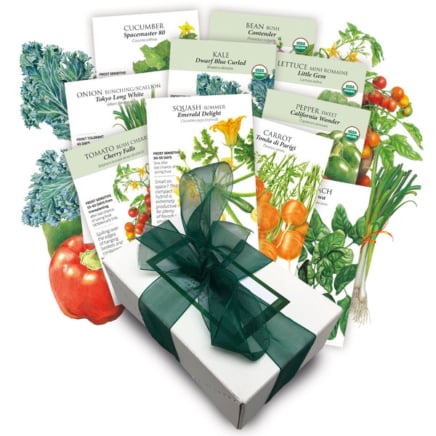
Container Vegetable Gift Set
Cherry Tomato

Patio Choice Cherry Tomato Seeds
Chile
Pepper

Thai Hot Chile Pepper Seeds
Which Buckets Are Best?
 Always use food-safe containers and avoid any that previously held chemicals or toxic substances.
Always use food-safe containers and avoid any that previously held chemicals or toxic substances.If you decide to include 5-gallon buckets in your vegetable garden, it’s important to source them properly. Not all are of equal quality. Choose food-safe buckets that haven’t been used to store toxic materials. Give them drainage holes every three inches or so. You can drill these into the bottom with a 2/38mm drill bit.
Check in with your local extension office to find out what they recommend. Some extension offices even sell food-grade buckets that help you get started on the right foot.
Try These Combinations
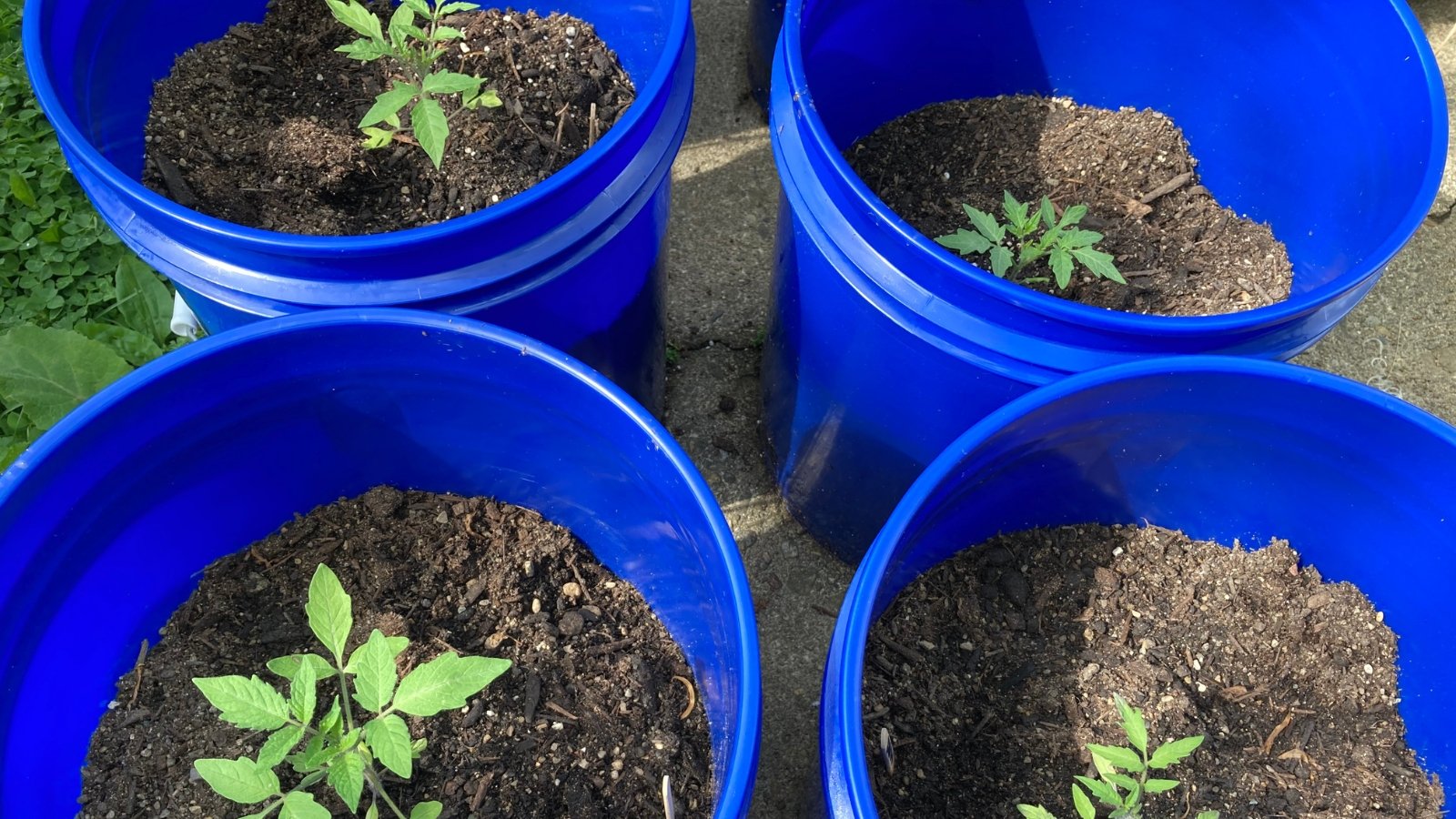 Experiment with spacing and combinations that suit your space.
Experiment with spacing and combinations that suit your space.Buckets aren’t just for growing one plant at a time. Even with larger plants, and nutrient-needy ones, you can pop multiple into a 5-gallon bucket. Use this list to give you an idea of how to interplant to get even more out of your growing space. In one bucket, you can grow the following:
- 1 tomato, pepper, or zucchini
- 3-4 lettuce
- 1 cabbage or broccoli (with 15 radishes)
- 15 carrots or beets
- 6 bulbing onions, garlic, or leeks
- 8 kale plants or beets for greens
Experiment with your favorite combination, giving some attention to nutrient and spacing needs. You may find you can grow even more in one bucket than what is on this list.
19 Plants for 5-Gallon Buckets
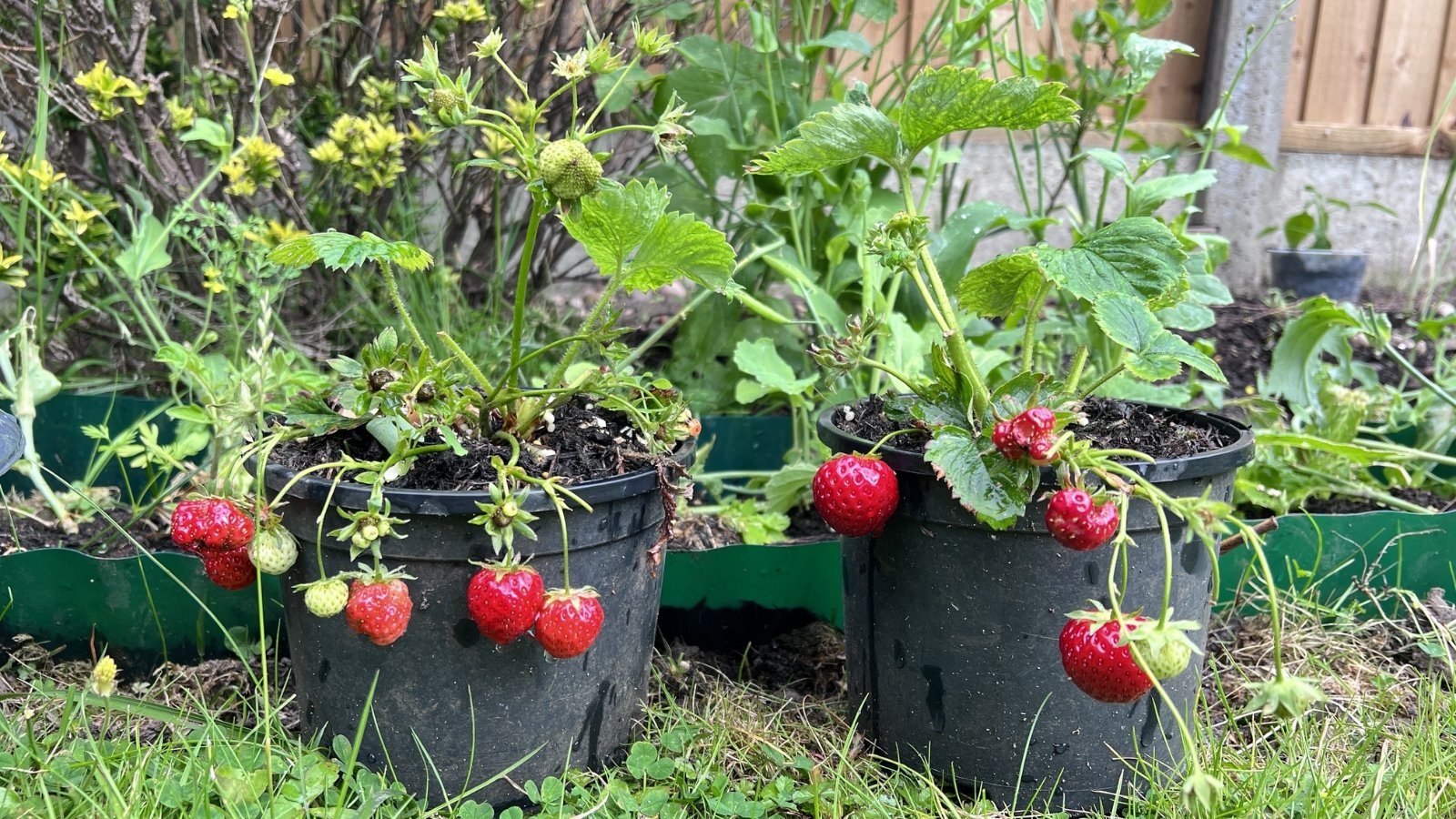 Experiment with spacing and combinations that suit your space.
Experiment with spacing and combinations that suit your space.This list covers quite a bit of ground, but it does not cover every single plant you can grow in a bucket garden. Use your best judgement when it comes to spacing, and see if the following works for you and your garden.
Tomatoes
 Start tomato seeds indoors 4–6 weeks before frost; use a heat mat for best germination.
Start tomato seeds indoors 4–6 weeks before frost; use a heat mat for best germination.Pretty much everyone enjoys a fresh tomato off the vine in the summer. These plants are a favorite in cultivation, too, due to their productive nature. Determinate tomatoes are perfect for 5-gallon buckets, and patio varieties are even better.
Start your tomatoes soon enough, and you’re good to go. Growers in most regions should start their seeds indoors at least four to six weeks before your last frost. Soil temps should be between 70 and 90°F (21-32°C) for best germination. A heat mat is great for starting tomato seeds.
For a lush cherry tomato that doesn’t exceed two feet, look for ‘Patio Choice’, which offers golden harvests perfect for canning, roasting, or drying in a compact plant under two feet. ‘Cherry Falls’ has a similar height and has a vigorous growth habit with tons of produce. If you’re looking for a more traditional tom, try 2014 All America Selection Heartland awardee ‘Mountain Merit, ’ which produces eight to ten ounce slicers.

Potatoes
 Start potatoes in containers 2–4 weeks before frost using determinate types for easier care.
Start potatoes in containers 2–4 weeks before frost using determinate types for easier care.If tomatoes are the most beloved cultivated veggie, potatoes are a close second. Growing them in a bucket is highly doable, and sometimes preferable for growers in areas with hot summers. Pop them in your buckets two to four weeks before your last frost in spring. Just like tomatoes, a determinate variety is easier to cultivate, and requires only one or two hillings.
For regular-sized varieties, planting two to five seed potatoes is just enough. Smaller varieties like ‘Fingerling’ offer delicious tubers in a smaller size, with deep purple skin and white flesh. For purple interiors, try ‘Adirondack Blue,’ which is a regular-sized potato with purple skin and flesh. ‘Yukon Gold’ is a standard potato that grows nicely in containers.
Peppers
 Grow any pepper variety in containers; start indoors 8–10 weeks before frost with heat mats.
Grow any pepper variety in containers; start indoors 8–10 weeks before frost with heat mats.The great thing about peppers is every variety can grow in a bucket. From cayenne, to shishito, to bell peppers or jalapeños, plant any of your favorites and grow them on a small scale. Just like tomatoes, start peppers indoors ahead of the growing season in a warm area. Break out that heat mat, and pop those seeds in eight to ten weeks ahead of your last frost.
For spice lovers, Thai hot chile peppers are a great choice. ‘Sweet Banana’ peppers have lots of delectable sweetness and lack the spice some find overwhelming. For just a touch of spice and deep purple accents, look out for ‘Pasilla Bajio Chilaca’ peppers. This one is perfect for red enchilada sauce.
Garlic
 This classic grows well in containers and rewards patience with flavor-packed bulbs after nine months.
This classic grows well in containers and rewards patience with flavor-packed bulbs after nine months.Yes, you can grow garlic in your 5-gallon-bucket vegetable garden setup. While it’s difficult to cultivate much more alongside your garlic plants, I have to tell you, it’s worth it. There is nothing more satisfying than harvesting bulbs that took nine months to cultivate, and there are so many varieties with an assortment of flavors.
Growers in colder climates have an easier time growing hardneck varieties, which require more chilling hours and more freeze-thaw cycles than softnecks. Softneck garlic is great for growers in the South, who don’t have as much freezing weather. Pop individual cloves in buckets in the fall, shelter them through extreme cold, and you’ll harvest in midsummer.
Kale
 Kale grows easily in most climates and doesn’t need warmth to sprout—skip the heat mat.
Kale grows easily in most climates and doesn’t need warmth to sprout—skip the heat mat.Kale is perhaps one of the easiest plants to grow, and the nutrition provided by each plant can’t be understated. Growers in every climate, even the coldest ones, find success in cultivating delicious, crunchy, rich green leaves of kale. You can start kale at the same time as your tomatoes, but keep it off the heat mat, as it doesn’t need warm soil to germinate.
If you can’t decide which kale variety you want to grow, pick a mix, like ‘Premier Blend’, which contains ‘Dwarf Blue Curled’, ‘Dwarf Siberian Improved’, ‘Lacinato’, and ‘Red Russian’ varieties. Harvest baby greens at 25 days, or grow giant vegetables and harvest them all at once to free up space in your 5-gallon buckets and to keep pest pressure down in warm weather.
Lettuce
 Lettuce grows fast in containers and pairs well with tomatoes, carrots, peas, and radishes.
Lettuce grows fast in containers and pairs well with tomatoes, carrots, peas, and radishes.Lettuce is an adaptable plant in a bucket garden. Not only can you grow lettuce quickly, but its shallow root system also allows you to grow it with other plants. Tomatoes, carrots, peas, and radishes are all great lettuce companions. Tucking your lettuce under another taller plant protects it from hot early summer weather, too.
Pick a butterhead or crisphead for harvests of full heads in about 80 days, or harvest baby greens of cos and mesclun types in about 25 days. Those in colder areas will have the best luck with lettuces that mature quickly, while those in mild climates can grow almost any type.
In high heat, lettuce bolts, so plant these in spring or fall in temperate climates. If you can’t decide what kind you want to have in your kitchen, try the ‘Gourmet Baby Greens Mesclun’ mix. This blend includes leaf lettuce, bib types, and romaine that you can harvest for baby greens or at full maturity.
Carrots
 Soak carrot seeds, then direct sow in cool soil; harvest roots after a light frost for sweetness.
Soak carrot seeds, then direct sow in cool soil; harvest roots after a light frost for sweetness.Luscious carrot roots are a joy to harvest, especially when they get a kiss of frost over winter in a mild climate. Grow these in buckets with the right spacing and timing. Give your carrot seeds a good soak for a few hours before planting them, and they’ll sprout more readily. These are some of the first plants you can directly seed in early spring, as they only need soil temperatures of 45°F (7°C) to sprout.
If you want to be able to plant even more in your buckets, choose smaller varieties, like the round roots of ‘Tonda di Parigi’ or the short ‘Little Finger’. But you don’t have to go this route, as standard types, like ‘Danvers,’ work just fine in buckets.
Radish
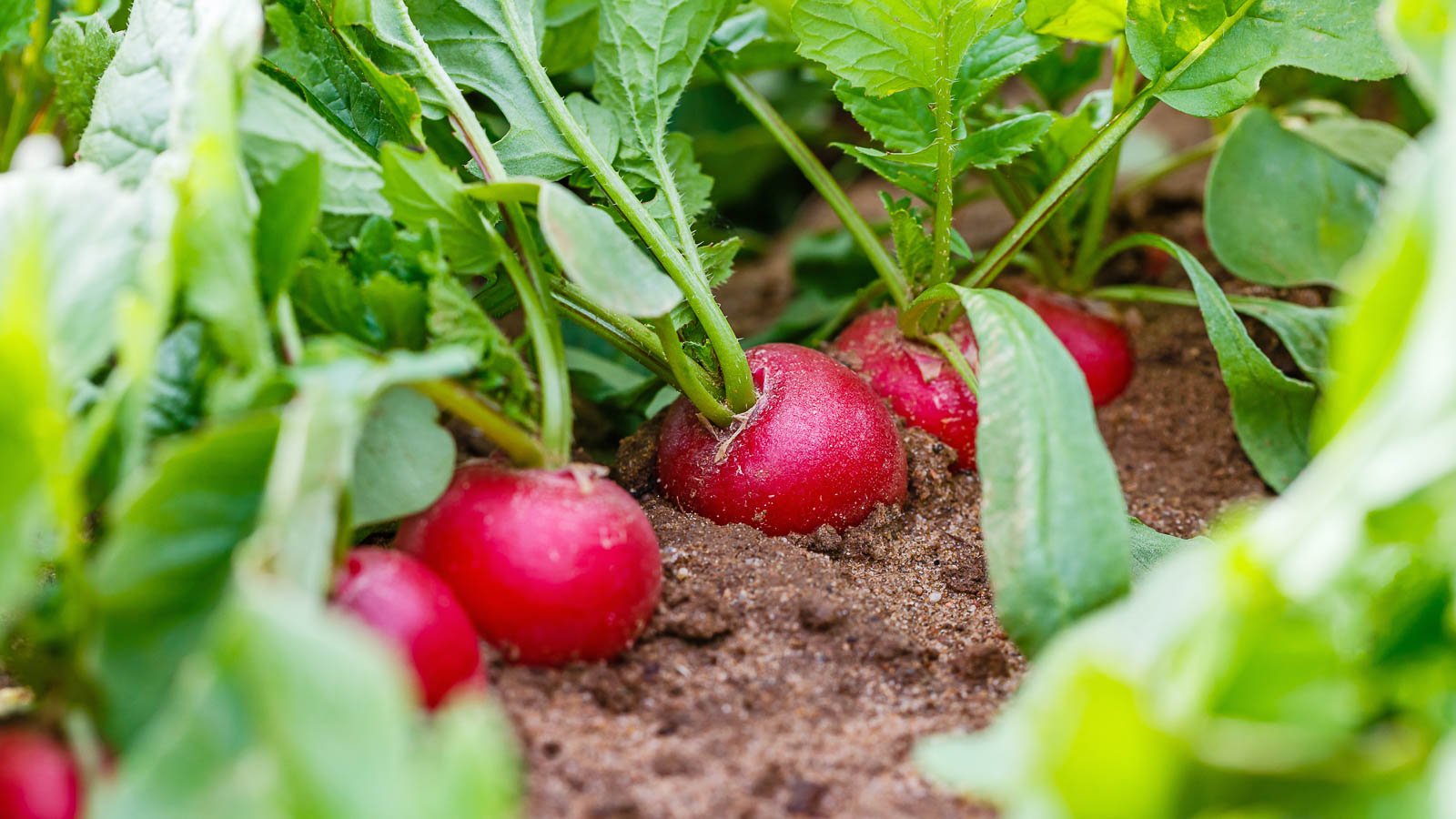 Sow radishes early in cool soil; succession plant every two weeks for steady harvests.
Sow radishes early in cool soil; succession plant every two weeks for steady harvests.Another early sower and quick cultivator is the beloved radish. Pop your seeds directly into 5-gallon buckets as soon as the soil temperature reaches 40°F (4°C), and wait about a month for your first harvest. If there are any veggies on this list that are meant for succession sowing, radishes are it. Two weeks after your first sowing, plant some more seeds to keep the harvest going.
While you can grow larger varieties in buckets (like daikon or black radishes), you’ll be most successful with smaller radishes. These take half the time and have a milder flavor than most larger types. Harvest as many as possible before heat sets in, and resume sowing in the fall if you live somewhere that gets hot in the summer. Heat can make these roots pithy and unpleasant.
Beets
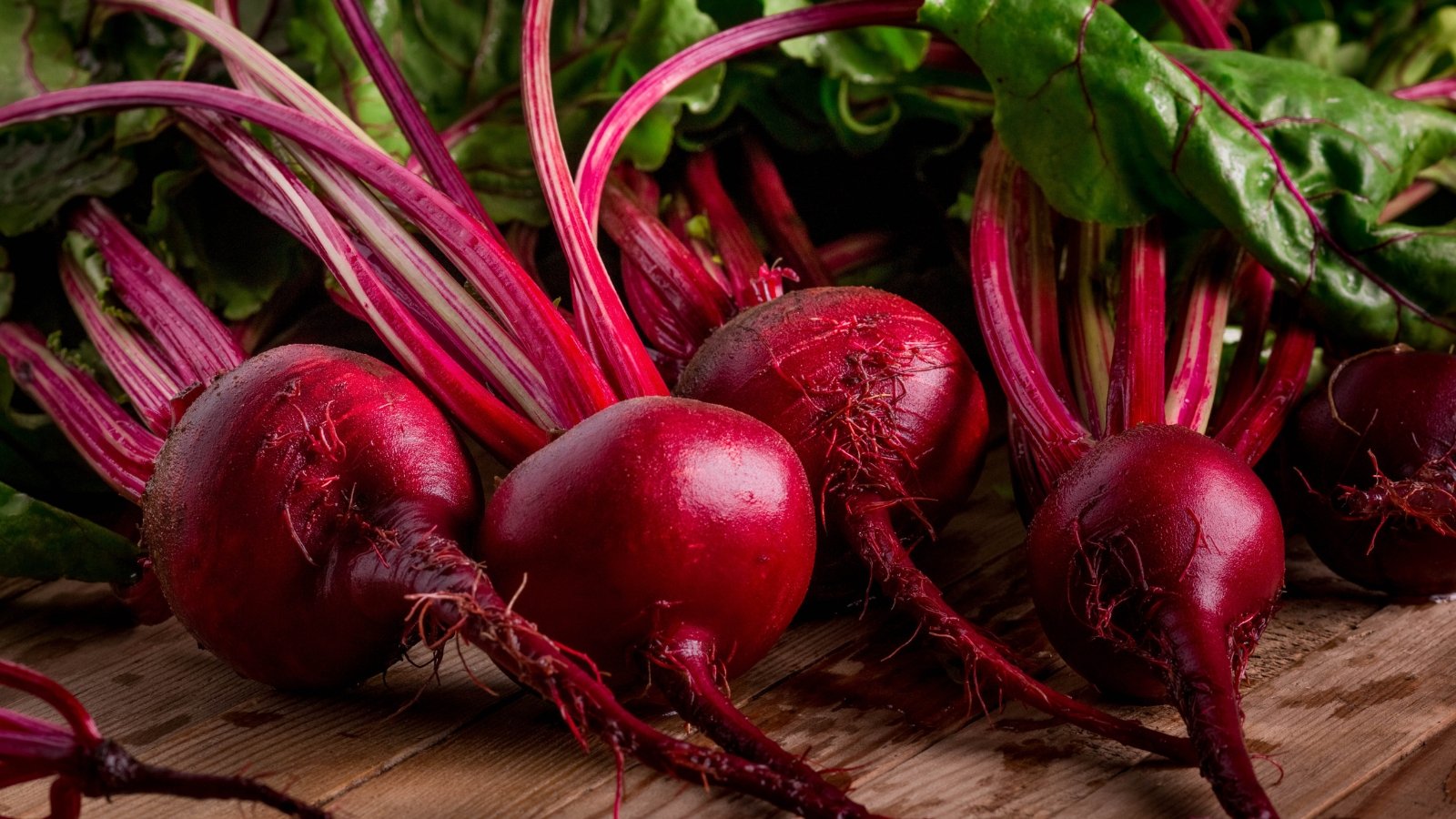 These root vegetables grow well in 5-gallon buckets and can be enjoyed fresh, pickled, roasted, or in colorful root mixes.
These root vegetables grow well in 5-gallon buckets and can be enjoyed fresh, pickled, roasted, or in colorful root mixes.Delicious, nutritious beets are another super rewarding vegetable crop to grow in your 5-gallon bucket space. Eat them fresh, grated on a salad, roasted with other root veggies, or pickled with your favorite fermenting veggies. These roots contain betalains, which have been studied for their ability to lower cholesterol levels.
Directly sow beet seeds of your preferred kind in your buckets two to four weeks before your last frost when soil temperatures are at least 45°F (7°C). If you opt for a smaller variety, like ‘Early Wonder,’ you can grow more at once in a shorter period of time (roughly 50 days). If the flavor of beets overwhelms you, try a golden beet variety instead.
Alliums
 Onions, chives, leeks, and alliums thrive in containers, attracting beneficial insects while deterring pests.
Onions, chives, leeks, and alliums thrive in containers, attracting beneficial insects while deterring pests.Chives, bulbing onions, leeks, and even flowering alliums thrive in buckets. They’re excellent companions that prevent pest feeding and infiltration into your garden. Their blooms also bring in beneficial insects. Whichever kind you grow, you’ll have lots of flavor to add to your dishes.
Sow allium seeds four to six weeks before your last frost outdoors. However, the recommended timing is sowing them indoors 10 to 12 weeks before the final frost. A heat mat is good for keeping the soil temperature between 60 and 85°F (16-29°C). Bulbing types are generally ready in a few months, and leaf alliums such as chives and scallions are ready within a couple of months.
Eggplant
 Eggplants need heat and indoor starts; grow one per container and harvest in mid-to-late summer.
Eggplants need heat and indoor starts; grow one per container and harvest in mid-to-late summer.Growing an aubergine plant in your buckets ensures you plenty of succulent veggies in the height of summer heat. In buckets, try smaller varieties, like ‘Jewel Amethyst’ which grows to just under two feet and produces three to four and a half inch eggplants. Buy your seeds from Botanical Interests, and you’ll get a bonus Gochujang Glazed Eggplant recipe inside the packet!
Eggplants are not as easy for cold climate growers who don’t have a sheltered area. Nevertheless, it’s recommended they should be started indoors on a heat mat at least ten weeks before your last frost. Grow just a few, and plant no more than one plant in each bucket. Then, get out some snips in the summer and get to harvesting.
Beans
 Grow pole beans with a trellis or choose bush types based on space and sunlight.
Grow pole beans with a trellis or choose bush types based on space and sunlight.Beans are the perfect vegetable for cultivating in 5-gallon buckets! Stick a trellis in your buckets if you’d like to grow a pole bean variety. Overall, bush beans are better suited to containers, but you can cultivate both types. Green beans, drying beans, cowpeas, and flatbeans alike grow well in buckets. You have to be discerning about where you put them and which ones you choose, though.
‘Contender’ bush beans are a solid stringless heirloom that has been around for over 70 years. They take only 50 days to grow from seed to bean. To attract hummingbirds to your veggie garden, try ‘Scarlet Emperor’ pole runners and trellis them well. Whatever type you choose, direct sow the beans when soil temperatures are 70 to 85°F (21-29°C), which usually occurs one to two weeks after your last frost.
Peas
 Trellis peas in early spring; soak seeds and sow with alliums, carrots, or radishes nearby.
Trellis peas in early spring; soak seeds and sow with alliums, carrots, or radishes nearby.Just as pole beans need a trellis, peas do too! Most peas grow early in the season, as they love cool weather. Soak your peas for 12 to 24 hours before planting. Then get them in the soil of your buckets four to six weeks before your last frost. Grow one plant per bucket, and interplant with alliums, carrots, or radish (or a combination of these).
Snap peas, snow peas, and shelling peas all love the cool crisp early spring air. There are some stunning peas out there, like ‘Sugar Magnolia’ snap peas, which don purple flowers and pods that resist powdery mildew. A small variety such as ‘Iona Shelling Petite’, topping out at 28 inches is a great choice for a small space garden. You won’t have to trellis these, and they are resistant to powdery mildew, bean leaf roll, and multiple races of fusarium.
Cucumber
 Choose compact cucumber varieties like ‘Spacemaster 80’ for container growing with minimal support needs.
Choose compact cucumber varieties like ‘Spacemaster 80’ for container growing with minimal support needs.The cool crunch of a cucumber on a hot summer day is all I think about in spring as I’m planting my summer garden. While many varieties grow long vines that need tons of support, opting for ‘Spacemaster 80’ ensures yours won’t exceed three feet. While these are sensitive to frost, they resist mildew, mosaic virus, and scab. This is the variety that made EG Founder Kevin a fan of Botanical Interests.
When your soil temperature reaches 60°F (16°C), you’re ready to plant these vegetable seeds directly in your 5-gallon buckets. As soon as the heat of summer sets in, get ready to harvest tons of these delicious cucurbits.
Summer Squash
 Stick with bush-type summer squash like zucchini or patty pan.
Stick with bush-type summer squash like zucchini or patty pan.In buckets, it’s best to stick to bush varieties of summer squash to ensure there’s enough space to grow your favorites. Patty pan, zucchini, and yellow types all fit the bill here. These are best sown in warm weather, directly in soil that is at least 70°F (21°C).
A blend of delicious patty pan squash is found in ‘Scallop Blend’ summer squash. Here you’ll get a combination of white, yellow, and green scallops in under two months. Harvest them at two inches wide for the most tender squash.
Berries
 Many berry bushes grow well in containers with acidic soil; blueberries are especially container-friendly.
Many berry bushes grow well in containers with acidic soil; blueberries are especially container-friendly.While it may seem impossible there are plenty of berry bushes that can be grown in 5 gallon buckets or containers. EG’s Jacques grew blueberries in a container with great success. He found it was easier, as many berries appreciate acidic soil. Throw in some soil acidifier with your potting soil and you’re set.
Dwarf berry bushes with the widest hardiness range include Sunshine Blue blueberry, Raspberry Shortcake, and Baby Cakes® blackberry. Any type of strawberry will do in a 5-gallon bucket. Plant multiple with one or two chamomile plants for better pollination.

Broccoli
 Grow broccoli or rapini in containers; sow early and harvest often with succession planting.
Grow broccoli or rapini in containers; sow early and harvest often with succession planting.Yummy and nutritious crowns of broccoli are great in buckets. While you won’t be able to grow more than one standard plant or just a few rapini per bucket, successive sowings make the harvest last. These are cold-tolerant, early-sow candidates that provide a ton of nutrition at harvest time.
Sow your seeds indoors or out four to six weeks before your last frost date. Transplant those sown indoors one to two weeks before your last frost to sweeten the crowns.
For a fusarium-resistant variety with purple florets in 68 to 75 days, go for ‘Burgundy Broccoli.’ This variety produces generous side shoots that make multiple harvests on one plant possible. Warm-climate growers have better luck with heat-tolerant ‘Kailaan’ or ‘Rapini.’ Each of these is ready in under two months.
Herbs
 Herbs thrive in containers and mix well with other crops or in dedicated herb containers.
Herbs thrive in containers and mix well with other crops or in dedicated herb containers.You can easily cultivate a thriving herb garden in 5-gallon buckets. Many herbs like to grow among each other and among other plants. Interplant these among many of the plants in our list, or just grow a bunch of them together and have a bucket herb garden.
Tomatoes with basil, potatoes, rosemary, and thyme planted with dill are viable duos. You can experiment, seeing which plants are happiest with one another. Remember to choose varieties and types that won’t overtake one another, and don’t rely on the same nutrients. For instance, mint is a bit of a bully and probably needs its own container.
Cabbage
 Grow cabbage by starting seeds indoors; plant one standard or two mini types per container.
Grow cabbage by starting seeds indoors; plant one standard or two mini types per container.The last veggie on our list is another cool-weather champ: cabbage! Singly plant standard-sized cabbages in your buckets. Grow a couple of smaller types, like ‘Caraflex’ in one planting area. Regardless of your spacing, get these seeds planted indoors six to eight weeks before your last frost.
Most types of cabbage are ready for harvest within 65 to 85 days. They are best grown in areas with mild weather, as hot heat brings out all the pests that love to dine on their supple leaves. It also signals to your cabbage that the season is over and it’s time to bolt.
Of course, you can always cover these with a critter cover and accompanying frost blanket to block out pests. In areas with hot summers, grow these in spring or fall using the first and last frost dates to guide your timing.


 2 months ago
96
2 months ago
96





















 English (US) ·
English (US) ·  French (CA) ·
French (CA) ·